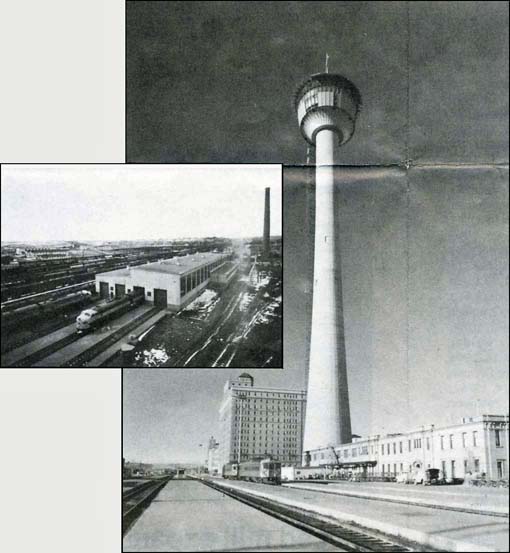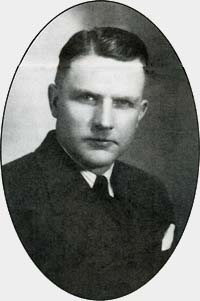With huge investments in railway, hotels, oil and gas, and a host of other economic
activities, Canadian Pacific had become one of the major players on the Alberta scene. Through two world wars, diversification and
modernization, inextricably linked to the changing fortune of the Canadian economy, the railway would reinvent itself time and time again.
But always it was up for the challenge. Night and day, seven days a week, year in, year out, the employees of the Canadian Pacific
Railway were...
On the Job
By Dave Jones C&PA Montreal

Alyth Diesel Shop and Calgary tower under construction.
The hiss of steam filled the cavernous expanse.
Overhead a hulking, streamlined Royal Hudson glided through the air like a cloud, to be placed gently on a shop track over a work pit in
the CPR's Ogden Shops.
When word came, it spread like a virus. The Nazis had invaded Poland. Canada was at war. All of the nation's resources would be needed.
Half-repaired locomotives soon would be side-tracked to make way for the armaments assembly lines that would equip the Allies' armies for
a modern, mechanized conflict.
But Ogden was awake. The railway's industrial capacity was second to none, its electrically driven air compressors providing high pressure
air to the latest generation of power tools. When the call came, Canadian Pacific was ready.
When war struck in 1939, Canadian Pacific was involved at once.
More than 272 million tonnes (300 million tons) of freight were moved, 86 million passengers were hauled on its trains, and 22 of its
ships were requisitioned by the British Admiralty for war service.
As had occurred more than two decades before, the mechanical department's industrial might was turned to the manufacture of munitions,
anti-aircraft guns, marine engines, and tanks.
The massive wartime effort helped to bring Alberta out of recession but foreshadowed an end that soon revolutionized communications in
Canada. Oil, discovered in Alberta's Turner Valley in 1914, would fuel an industry that would come to symbolize the province as surely as
the railway had. Things moved into high gear for the Alberta oil business when the Leduc field proved to be a winner in 1947. By 1952,
Canadian Pacific was collecting royalties on more than 400 oil wells in the province.
In 1958, Canadian Pacific Oil & Gas was incorporated to look after all of the company's energy resources and mineral rights. By 1971,
the name had been changed to PanCanadian Petroleum Ltd., and with the amalgamation of Central-Del Rio Oils Ltd., Canadian Pacific became
Canada's largest player in the petroleum business.
Another significant move in 1958 was the acquisition of Smith Transport. A year later, Canadian Pacific was operating 3,860 tractors,
trailers and other road vehicles.
In the 1960s, CPR President brought further diversification to the company, along with the desire to establish each entity within Canadian
Pacific as a "profit centre".
In 1962, Canadian Pacific Investments, headquartered in Calgary, was established to manage all of the company's non-rail assets.
Two new subsidiaries were formed: CP Hotels Ltd., and Marathon Realty. One of Marathon's first big redevelopment projects replaced
Calgary's CPR station and gardens with a complex of commercial and shopping facilities, an office tower, and an apartment building, over
which rose a 191-metre (626-foot) communications and observation tower with a revolving restaurant that would define the city's skyline
until this day.
With more people on the move, for both business and pleasure, the hotel industry experienced somewhat of a renaissance. By 1988, with the
absorption of CN's hotel operations, CP Hotels owned eight properties in Alberta: Hotel Macdonald in Edmonton, The Palliser and
Chateau Airport in Calgary, The Lodge at Kananaskis and Hotel Hananaskis, Jasper Park Lodge, Chateau Lake Louise, and the Banff Springs
Hotel.
In 1968, the company adopted a new symbol called the "multimark" to identify its various components: CP Rail, CP Ships,
CP Air, and so on. The name Canadian Pacific Railway Company no longer reflected the diversity of the company's many operations, and in
1971, the parent company's name was changed to Canadian Pacific Limited.
| |

N.R. "Buck" Crump - President then CEO 1955 to
1972.
|
While Crump's dieselization program was modernizing the CPR's motive power fleet, the
company was racking up annual losses in the neighborhood of $25 million on passenger, mail, and express services. Despite $500 million
investment in new, stainless-steel equipment for the transcontinental route in 1955, and the introduction of some 50 diesel
"dayliners" on secondary routes such as the Calgary to Edmonton run, the ascendency of the automobile and the increasing
viability of the airplane for long-distance movement of people and goods continued to play havoc with the bottom line.
In 1977, the federal government moved to fully subsidize inter-city rail passenger services in Canada. A new Crown corporation, VIA Rail
Canada, was created to take over and manage the combined passenger business of CN and Canadian Pacific.
While the 1970s proved to be trying times for passenger rail service, the freight business was booming. By 1971, upgrading programs at
Alyth Yard had transformed the facility into the ultramodern Alyth Diesel Shop, where minor repairs are undertaken even now on the latest
generation of AC-traction locomotives.
The huge Alyth classification yard was the largest fully automated operation of its kind on the continent. And an ambitious
double-tracking project between Calgary and Vancouver would culminate in the $500-million Rogers Pass Project the following decade, the
largest railway engineering endeavor since the construction of the main line. |